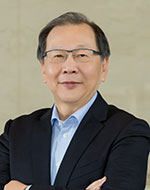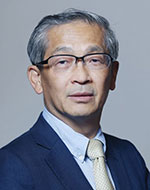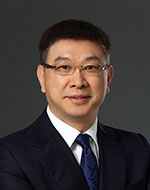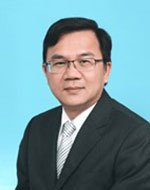TUESDAY, 8 DECEMBER 2020
Time: 09:00-10:30 (local time in Taipei)
Keynote A: Rick Tsai, CEO, MediaTek
Keynote B: Muriel Medard, Professor, Massachusetts Institute of Technology (MIT)
WEDNESDAY, 9 DECEMBER 2020
Time: 09:00-10:30 (local time in Taipei)
Keynote C: Jay Lee, Vice Chairman, Foxconn
Keynote D: David Tse, Professor, Stanford University
THURSDAY, 10 DECEMBER 2020
Time: 09:00-10:30 (local time in Taipei)
Keynote E: William Xu, Director of Board, President of the Institute of Strategy Research, Huawei
Keynote F: Chau-Young Lin, President, Chunghwa Telecomm Laboratories
Keynote Speakers
The following keynote speakers have been confirmed for IEEE GLOBECOM 2020.
Tuesday, 8 December 2020
Time: 09:00-10:30 (local time in Taipei)
 Rick Tsai
Rick Tsai
CEO, MediaTek
Title: ACCELERATING THE DIGITAL ECONOMY POST COVID-19 PANDEMIC
Abstract: Global economy took a serious hit by the outbreak of COVID-19 pandemic. Many traditional business sectors have been severely impacted. On the other hand, because many of our daily activities have gone virtual, the digital economy has received a surprising boost. With news of vaccines and their promising results, hopefully the pandemic will finally be over in the foreseeable future. We will look at trends of the technologies that help accelerate the digital economy during and even post the pandemic, and, in particular, the role that integrated circuit design plays in achieving the technological advancement.
Biography: Dr. Rick Tsai currently serves as Chief Executive Officer of MediaTek Incorporated, a global fabless semiconductor company that enables 1.5 billion connected devices a year; an industry leader in innovative systems-on-chip (SoC) platforms for mobile, home, connectivity, IoT and automotive products.
Prior to his current role at MediaTek, from 2014 to 2016, Dr. Tsai served as Chairman and Chief Executive Officer of Chunghwa Telecom Co., Ltd., Taiwan’s largest integrated telecom service provider. Under his leadership, Chunghwa telecom launched its – and Taiwan’s first - 4G mobile broadband services in 2015. In the months following Taiwan’s 4G penetration rate was recorded as the fastest growth among worldwide markets. Dr. Tsai also took a leading role in promoting high-speed fiber broadband services and developing new businesses such as ICT, IoT and multimedia convergence as company’s future growth drivers. He was elected by Finance Asia as one of Taiwan’s three best CEOs in 2016.
In 1989, Dr. Tsai joined TSMC as an engineering manager and rose through the ranks to hold key executive positions such as Fab Director, EVP of Operations, EVP of Worldwide Sales and Marketing, President and COO. During this period, Dr. Tsai also assumed the position of President at Vanguard International Semiconductor, a TSMC affiliate, between 1998 to 2000. During his time at TSMC, he gained significant Sales, Marketing and Management experience. He assumed the position of President and CEO of TSMC in 2005. In 2009, Dr. Tsai was assigned to become President of New Businesses until 2011.
Dr. Tsai has served as a member of the board of directors in various companies, such as Lam Research Corporation, NXP Semiconductors N.V., USI Corporation, and Chunghwa Telecom. He previously served on the board of directors of TSMC from 2003 to 2013; TSMC Solar and TSMC SSL from 2011 to 2014, where he also served as their Chairman; and Taiwan Semiconductor Industry Association (TSIA) from 2009 to 2013, where he served as Chairman.
Dr. Tsai received his B.S. in Physics from National Taiwan University and Ph.D. degree in Material Science and Engineering from Cornell University, U.S.A.
 Muriel Medard
Muriel Medard
Professor, Massachusetts Institute of Technology (MIT)
Title: WHY IS LOW DELAY TAKING SO LONG
Abstract: Ultra-reliable low-latency (URLLC) has been touted as a crucial capability of all future generations of communications. It is core to self-driving cars, virtual reality, or any delay-sensitive service. The practice behinds lags the promise. 4G and 5G have been operating through a dense, complex sheaf of layers that compound inefficiencies. The common countermeasure has been bandwidth over-provisioning, in effect wasting resources. In this talk, we consider multiple wireless layers and show how using revisiting codes can radically change network operation. Surprisingly, all the codes are all quite simple, or even already in use. The trick lies in the decoding. At the physical layer, construction of error-correcting capacity achieving codes has pushed towards long codes, with bespoke decoders. Guessing random additive noise decoding (GRAND), which is noise-centric, allows for any high rate error-correcting code. Even simple codes, or random codes, with GRAND match or outperform the state of the art encoders and decoders. GRAND is able to make use of any noise structure, including correlation, obviating the usefulness of interleavers, a considerable cause of delay. At the medium access layer, cumbersome overlays of hybrid- and straight automatic request retransmission (H-ARQ and ARQ), which are intra-frame based, can be improved by error correction or, using random linear network coding, erasure correction across frames. At the transport layer, random linear coding can effectively trade off between in-order delay and goodput. Here again, the encoding is simple, and the decoding universal for all erasure-correcting codes, lending itself to customization for network slicing.
Biography: Muriel Médard is the Cecil H. Green Professor in the Electrical Engineering and Computer Science (EECS) Department at MIT and leads the Network Coding and Reliable Communications Group at the Research Laboratory for Electronics at MIT. She has served as editor for many publications of the Institute of Electrical and Electronics Engineers (IEEE), of which she was elected Fellow, and she has served as Editor in Chief of the IEEE Journal on Selected Areas in Communications. She was President of the IEEE Information Theory Society in 2012, and served on its board of governors for eleven years. She has served as technical program committee co-chair of many of the major conferences in information theory, communications and networking. She received the 2019 Best Paper award for IEEE Transactions on Network Science and Engineering, 2009 IEEE Communication Society and Information Theory Society Joint Paper Award, the 2009 William R. Bennett Prize in the Field of Communications Networking, the 2002 IEEE Leon K. Kirchmayer Prize Paper Award, the 2018 ACM SIGCOMM Test of Time Paper Award and several conference paper awards. She was co-winner of the MIT 2004 Harold E. Edgerton Faculty Achievement Award, received the 2013 EECS Graduate Student Association Mentor Award and served as undergraduate Faculty in Residence for seven years. In 2007 she was named a Gilbreth Lecturer by the U.S. National Academy of Engineering. She received the 2016 IEEE Vehicular Technology James Evans Avant Garde Award, the 2017 Aaron Wyner Distinguished Service Award from the IEEE Information Theory Society and the 2017 IEEE Communications Society Edwin Howard Armstrong Achievement Award. She is a member of the National Academy of Inventors. She was elected Member of the National Academy of Engineering in 2020.
Wednesday, 9 December 2020
Time: 09:00-10:30 (local time in Taipei)
 Jay Lee
Jay Lee
Vice Chairman, Foxconn
Title: INDUSTRIAL AI FOR SMART DIGITAL TRANSFORMATION
Abstract:
This presentation will introduce the trends, recent advances, and case studies of Industrial AI for smart digital transformation. Currently, industry is shifting towards the phase of Industry 4.0. The development of intelligent manufacturing and Industrial Internet technologies has allowed us to see a trend in which the “localized intelligence” and “interconnected intelligence” directions of industrial systems go hand in hand, and are evolving towards the integration of horizontal and vertical intelligent application systems. On one hand, the rapid development of sensors and communication technologies allows for a big data ecosystem and powerful computing power for industrial systems. On the other hand, the development of Industrial Internet makes for more connected equipment, people, and services, and generates more value for businesses.
Industrial AI is a systematic discipline which focuses on developing, validating, and deploying various machine learning algorithms for industrial applications with sustainable performance. It brings rich opportunities in smart industrial digital transformation including smart manufacturing, which should consist of rapidly improving the quality, constitution, and essence in manufacturing. For example, by standardizing the workflow of a person with data and establishing a better reference and relationship with data, people’s experience can quickly be accumulated and passed on. By using data, implicit problems in manufacturing systems can be explicit, so that the health status of equipment can be transparently managed, process parameters can become more stable, and comprehensive efficiency can be more coordinated and optimized. Data is used as a medium to increase users’ value, to help users enhance the functionality and reliability of products and equipment, optimize operating efficiency, and enhance the sustainable profitability of enterprises.
As AI enters industrial systems, it must fulfill 5S principles namely Systematic, Speed, Streamlining, Standards, Sustainable. In addition, Industrial AI is a systematic discipline and requires the integration of several technical elements, the six of which we will refer to as “ABCDEF”: Analytics, Big Data, Computational Platform, Domain Knowledge, Evidence and Feedback.
In summary, the goal of the future Industrial Intelligence system is to create a worry-free industrial environment to achieve predictive, resilient, and sustainable performance.
Biography: Dr. Jay Lee is Ohio Eminent Scholar, L.W. Scott Alter Chair Professor, and Univ. Distinguished Professor and is founding director of National Science Foundation (NSF) Industry/University Cooperative Research Center (I/UCRC) on Intelligent Maintenance Systems which consists of the Univ. of Cincinnati (lead institution), the Univ. of Michigan, and the Univ. of Texas-Austin. Since its inception in 2001, the Center has been supported by over 100 global companies. The IMS Center was selected as the most economically impactful I/UCRC in the NSF Economic Impact Study Report in 2012. He has mentored his students and developed a number of start-up companies including Predictronics (a start-up company from NSF IMS Center of the Univ. of Cincinnati through NSF ICorp award in 2012), etc. He has also advised his students to win the 1st Place PHM Data Challenges five time out of nine competitions since 2008. In addition, he is the Founding Director of Industrial AI Center.
Currently, he is on leave from Univ. of Cincinnati to serve as Vice Chairman and Board Member of Foxconn Technology Group. He also serves as a member of Board of Governors of the Manufacturing Executive Leadership Council of National Association of Manufacturers (NAM), as well as a member of the Global Future Council on Advanced Manufacturing and Production of the World Economics Council (WEF) to engage the global leaders for the development of collaborative activities in smart manufacturing.
Previously, he served as senior advisor to McKinsey & Company. Prior to his academic career, he served as Director for Product Development and Manufacturing at United Technologies Research Center (UTRC) as well as Program Directors for a number of programs at NSF including the Engineering Research Centers (ERC) Program, the Industry/University Cooperative Research Centers (I/UCRC) Program, and Materials Processing, and Manufacturing Program at the Design, Manufacture, and Industrial Innovation Division, etc.,
He is a fellow of ASME, SME, PHM (Prognostics and Health Management), as well as a founding fellow of International Society of Engineering Asset Management (ISEAM). He is a frequently invited speaker and has delivered over 270 keynote and plenary speeches at major international conferences He has received a number of awards including the Prognostics Innovation Award at NI Week by National Instruments in 2012, NSF Alex Schwarzkopf Technological Innovation Prize in 2014, MFPT (Machinery Failure Prevention Technology Society) Jack Frarey Award in 2014, and PICMET Medal of Excellence in 2016. He was selected as 30 Visionaries in Smart Manufacturing in by SME in Jan. 2016 and 20 most influential professors in Smart Manufacturing in June 2020.
 David Tse
David Tse
Professor, Stanford University
Title: SCALING BLOCKCHAINS
Abstract: Existing blockchains like Bitcoin and Ethereum have excellent security against adversarial attacks but their transaction throughputs and confirmation latencies are very poor, far away from the physical communication, computing and storage limits of the network. This talk discusses how blockchains can be scaled to these physical limits. Ideas from communication, coding and information theory are highlighted
Biography: David Tse is the Thomas Kailath and Guanghan Xu Professor in the School of Engineering at Stanford University. He is a member of the U.S. National Academy of Engineering. He received the 2017 Claude E. Shannon Award and the 2019 IEEE Richard W. Hamming Medal. He is the inventor of the proportional-fair scheduling algorithm, used in all modern-day cellular systems serving 3 billion subscribers around the world. His research interests are in information theory, blockchains and machine learning.
Thursday, 10 December 2020
Time: 09:00-10:30 (local time in Taipei)
 William Xu
William Xu
Director of Board, President of the Institute of Strategy Research, Huawei
Title: THE FUTURE OF INTELLIGENT CONNECTIVITY
Abstract: As the ICT becomes the foundational platform for the digital economy, the vertical business is experiencing the digital transformation, the ICT technology is igniting the huge potential to make revolutionary impact in each and every business. In this keynote, we present the drivers and momentum for the future of intelligent connectivity, as well as the challenges. In addition to the emerging 5.5G to meet the demand of near term 5G evolution, we also point out the directions of two critical areas for ICT, the connectivity and computing; in particular, we discuss the paradigm-changing research topics and associated open technical issues, first, the semantic communications based on the machine learning technology, this is a new fundamental framework after the classical Shannon theory, and the communication is no based on the bit-level, rather based on machine intelligence, it has the potential to improve the communications efficiency at semantic level and to surpass the Shannon limit, second, to revisit the computing framework by examining the so-called approximation computing, such that we can based on the algorithm-of-choice to drastically reduce the computing hardware and software complexity, this is especially powerful with respect to the huge dimensional commuting tasks. In this talk, we put emphasis on the importance of investment on the fundamental research, and the effort on the basic technology breakthrough. We also articulate and promote the open and collaborate research among the academia, industry partners and governments to jointly shape the future of intelligent connectivity.
Biography: William Xu was born in Changzhou, Jiangsu Province in 1963. He was admitted to the Department of Automatic Control of Nanjing Institute of Technology in 1980, and received a bachelor's degree from Nanjing Institute of Technology and a master's from Southeast University. He joined Huawei in 1991, and currently serves as Huawei's Director of the Board and President of the Institute of Strategic Research.
Mr. Xu has served as Huawei's President of Research, President of R&D, President of the European Area, President of HiSilicon, Chief Sales & Service Officer, CEO of the Enterprise BG, and Chairman of the Investment Review Board. He has achieved many great things in product R&D, marketing, strategy development, and market presence planning, all of which have contributed to Huawei's leading position in the world. Mr. Xu is a strategy scientist with an international outlook and extensive experience of success in the industry. He displays outstanding strategic thinking during high-level design, has global influence, and is capable of guiding industry development.
Mr. Xu has an extensive scientific and technical background and has led Huawei's product and technology R&D for many years, as well as being responsible for work related to chip design, general technology, and research. He led the development of Huawei's first generation of public program-controlled switches, and oversaw the design of the company's first chip and the establishment of the chip design center – the predecessor to HiSilicon. In addition, he has substantial market insights and deep knowledge of industry trends, supports the translation of research results into industry applications, creates new markets, and leads industry development. He has led Huawei into the Innovation 2.0 era, which is a shift from engineering and technical innovation (from 1 to N) to theoretical breakthroughs and technical inventions (from 0 to 1).
As the President of the Institute of Strategy Research, Mr. Xu is responsible for Huawei's basic research and cutting-edge technology research, as well as collaboration with over 300 universities around the world. Mr. Xu directs future-oriented research into basic, cutting-edge, and disruptive technologies that will help overcome worldwide technological challenges in photonic computing, free-electron laser, naked-eye 3D, and healthcare. This research will guarantee Huawei's presence in these technology fields over the next 5–10 years, fill Huawei's gaps, and enhance Huawei's strengths, preventing the company from losing its way or missing out on future opportunities.
Currently, Mr. Xu is committed to innovations related to next-generation optical computing, optical transmission, and new display technologies, such as optical switch matrix operations, few-mode multicore fiber transmission, and light field displays based on micro- and nano-grating. These innovations aim to achieve the creation of large-scale, high-speed optical computing chips, ultra-large-capacity optical transmission technology, and next-generation naked-eye 3D display technology. Mr. Xu's team is collaborating with global universities and research institutes on 18 projects. Their work covers theories, structure design, system encapsulation, and prototype implementation that will enhance Huawei's research and presence in strategic technologies over the next 5–10 years.
 Chau-Young Lin
Chau-Young Lin
President, Telecommunication Laboratories, Chunghwa Telecom
Title: 5G OPPORTUNITIES FOR TELCOS
Abstract:
Over the past decades, the technologies in telecommunication have been improved tremendously. The telecom companies also face the challenges brought by the new technologies and rivals, without exception, in the upcoming 5G era.
The traditional telcos first met competitions from VoIP service providers, even instant messengers and social media, such as Skype, WhatsApp, LINE, Facebook and Twitter. Their revenues from voice call and SMS are gradually eroded. Furthermore, the video streaming and cloud services become more and more popular in these years, and the demands for data bandwidth are also boosting up. However, the flat rate of data connection plans and rivals in the market have made the traditional telcos struggle.
5G service is indeed an opportunity for telcos, and it is the last piece of puzzle of complete ICT solutions for consumers and enterprises. By the help of 5G, the features of ultrahigh speed, low latency and massive end-to-end connections will lead a new scenario of telecom service. Moreover, integrating the AI, Big Data, Cloud and AR/MR/VR technologies, 5G could leverage the domain know-how in different applications, such as manufacturing, healthcare, IoT and autonomous vehicles, to a new vision we have never had before.
This year, the pandemic of COVID-19 has seriously damaged the global economy. Meanwhile, digital transformation has been escalated as a priority goal in many enterprises. For the leaders of telcos, dealing with the impacts from the pandemic and embracing the desires of digital transformation from customers are tough trials.
Biography: Dr. Chau-Young Lin is both president of Data Communication Business Group and president of Telecommunication Laboratories, Chunghwa Telecom since July 2020. Dr. Lin is also the chairman of the board of International Integrated Systems, Inc. (IISI), an international and professional benchmark company of ICTs in large-scale system implementation and software development is headquartered in Taipei, Taiwan.
Prior to the current position, he was designated as the senior executive vice president of Chunghwa Telecom since August 2019 and has served as executive positions of several business groups of Chunghwa Telecom from 2010-2019. In 2010, Dr. Lin initiated the “Taxation Information System Reform Project” for the Financial Data Center, Ministry of Finance of Taiwan, a fundamentally and revolutionary project enabling the goal of satisfying public taxation information service demands by providing innovative and convenient services, such as taxpayer-oriented service, centralized and unique taxpayer registration service, and Internet tax filling and payment services.
Dr. Lin joined Chunghwa Telecom in 1987 as a researcher of Telecommunication Laboratories and led the developments of large-scale information systems such as TOPS (Telecom Operation Process System), MBMS (Mobile Billing Management System) project and especially the “Next Generation Business Support System” (NGOSS-BSS), which was intended to consolidate each individual Business Support Systems of fixed-line, mobile and data communication business into a single integrated BSS, this could facilitate the bundle/blend services for enterprises and NGN (Next-Generation Network) customers.
Dr. Lin holds a PhD degree in Electronic engineering of National Taiwan University of Science and Technology, Taipei, Taiwan. He is the members of the Institute of Electric and Electronics Engineers (IEEE), Computer Society, the Association for Computing Machinery (ACM), and the Taiwanese Association for Artificial Intelligence (TAAI) as well.
Dr. Lin is full of experiences in software engineering and development of large-scale information systems. His expertise includes ontology modeling, SOA, NGOSS, ITIL, CMMI and systems re-engineering.






















